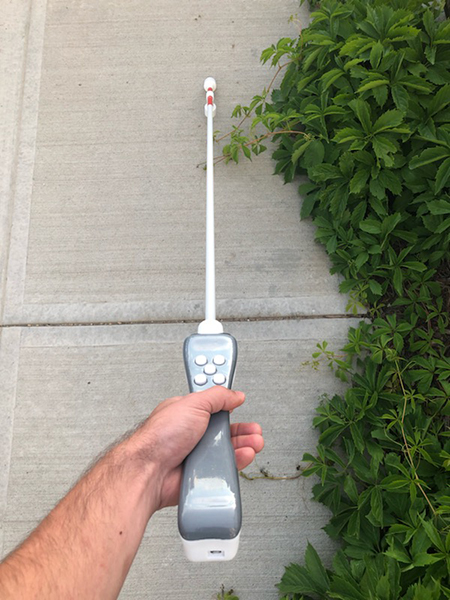Efforts earn Capstone Project of the Year Award
A trio of Biomedical Engineering Technology students turned a final class project into a smart cane that could improve the safety and confidence of people with vision loss.
Nathaniel Painchaud, Dan Oake and Navneet Kaler (class of 2018) were classmates at NAIT when they were tasked with combining their learning from previous semesters to create a technology-enhanced seeing-eye cane for their final project, or capstone.
The prototype device, which they called the VISAIDE Smart Cane, fulfilled a desire to create an assistive technology tool that’s simple to use.
“We wanted to create something that would have a positive and immediate impact on the lives of the individuals relying on the technologies,” says Painchaud.
“We wanted to create something that would have a positive and immediate impact.”
When they started, the classmates were focused on improving a tool that had seen little innovation during the last century. Though they had no idea their invention would garner attention or accolades, the trio was recently recognized by the Association of Science and Engineering Technology Professionals of Alberta (ASET).
Advanced obstacle detection
Designed and built entirely by Painchaud, Oake and Kaler, the smart cane has the potential to help people with vision loss navigate unfamiliar surroundings through two intuitive features.
 The first is what Painchaud calls advanced obstacle detection and avoidance, where two sensors send signals to the user about their physical surroundings.
The first is what Painchaud calls advanced obstacle detection and avoidance, where two sensors send signals to the user about their physical surroundings.
A series of vibrations warns of potential ground-level barriers such as large puddles or ice. It can also detect hazards such as overhanging tree branches and or people blocking the user’s path.
“The proximity sensor we installed in the handle and the water sensor in the cane’s tip will continually collect information about the user’s surroundings and relay that information back to them,” he says
The second feature connects the cane to a smartphone via Bluetooth. This feature turns the cane’s handle into a remote control for the user’s iPhone, giving them access to functions such as GPS, walking directions, sending and reading text messages and making phone calls.
Award-winning innovation
Apart from several technical requirements, capstone projects are based on students’ own ideas and inventions to solve a real-world problem.
Their work on VISAIDE Smart Cane earned Painchaud, Oake and Kaler ASET’s 2020 Capstone Project of the Year Award, besting four other finalists from Alberta post-secondary institutions. (One of those teams was led by fellow NAIT grads Sebastian Potoniec (Electrical Engineering Technology ’19) and Noah Neiman (Electrical Engineering Technology ’18) for their project on the automation of an indoor farm.)
“The VISAIDE Smart Cane … is an outstanding example of the high calibre of innovation and commitment to the public good we see embodied in the capstone projects prepared by engineering technology students across the province,” said ASET CEO Barry Cavanaugh in a news release.
“The award came as an absolute shock … It’s definitely something we’re all very proud of.”
The trio’s work has also resulted in a whirlwind of media interviews about their invention, which were broadcasted across Canada. Painchaud admits that he and his former classmates have been pleasantly surprised by the response.
“The award came as an absolute shock and we’ve been so overwhelmed by the response we’ve received. It’s definitely something we’re all very proud of.”
Painchaud adds that the group had no immediate plans for their invention beyond the final assignment, but the extra attention has given them something to think about.
“We will need to discuss what the next steps are and go from there.”
Returning to NAIT
Since graduation two years ago, the group of classmates have turned their focus to their careers.
For Painchaud, that’s meant a return to NAIT – this time as an instructor in Biomedical Engineering Technology. The transition to instructor has been a bit “weird,” he says, but he’s able to give back to the program where he gained so much.
“I’m excited to be here and to be part of a student’s journey from day one.”
“I’m excited to be here and to be part of a student’s journey from day one … and help provide them the knowledge and experience that will see them work with practical, intuitive technologies to help people navigate health-based challenges.”